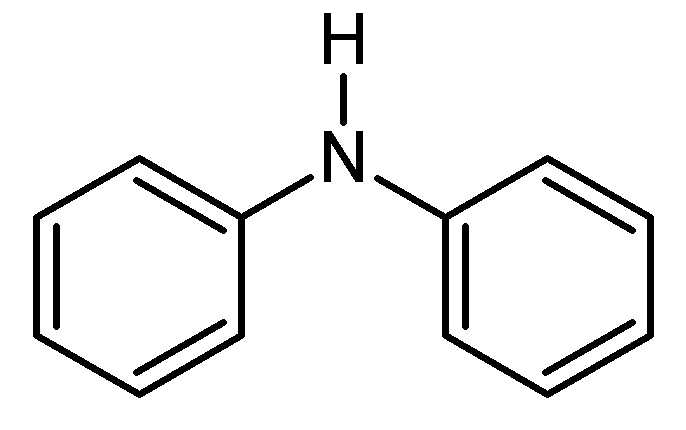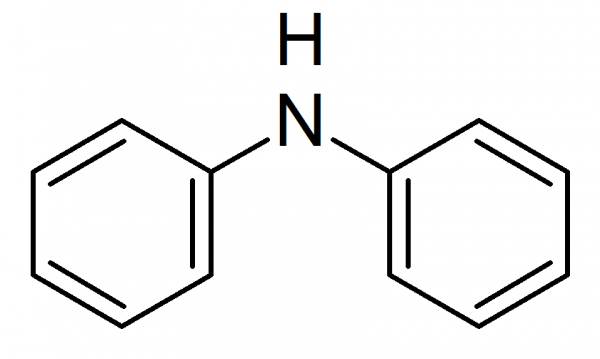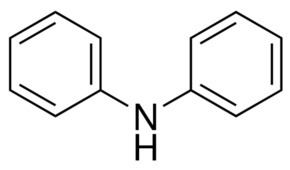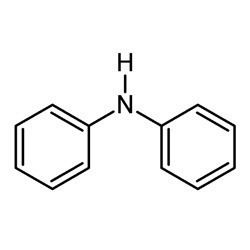Abbreviations DPA Melting point 53 °C Density 1.2 g/cm³ | Formula C12H11N Molar mass 169.23 g/mol Boiling point 302 °C | |
 | ||
Appearance White, tan, amber, or brown crystals Thermodynamicdata Phase behavioursolid–liquid–gas | ||
Forbidden fruit europe bans cancer causing u s apples over chemical diphenylamine may 13 2014
Diphenylamine is an organic compound with the formula (C6H5)2NH. The compound is a derivative of aniline, consisting of an amine bound to two phenyl groups. The compound is a colorless solid, but commercial samples are often yellow due to oxidized impurities. Diphenylamine dissolves well in many common organic solvents, and is moderately soluble in water. It is used mainly for its antioxidant properties.
Contents
- Forbidden fruit europe bans cancer causing u s apples over chemical diphenylamine may 13 2014
- Preparation and reactivity
- Antioxidant
- Other uses
- Toxicity
- Environmental fate
- Residues in fruit and alternatives
- Europe
- WHOFAO joint committee
- US EPA
- References

Preparation and reactivity
Diphenylamine is manufactured by the thermal deamination of aniline over oxide catalysts:
2 C6H5NH2 → (C6H5)2NH + NH3
It is a weak base, with a Kb of 10−14. With strong acids, it forms salts. For example, treatment with sulfuric acid gives the bisulfate [C6H5)2NH2]+[HSO4]− as a white or yellowish powder with m.p. 123-125 °C.
Diphenylamine undergoes various cyclisation reactions. With sulfur, it gives phenothiazine, a precursor to pharmaceuticals.
(C6H5)2NH + 2 S → S(C6H4)2NH + H2SWith iodine, it undergoes dehydrogenation to give carbazole, with release of hydrogen iodide:
(C6H5)2NH + I2 → (C6H4)2NH + 2 HIArylation with iodobenzene gives triphenylamine.
Antioxidant

Diphenylamine is used as a pre- or postharvest scald inhibitor for apples applied as an indoor drench treatment. Its anti-scald activity is the result of its antioxidant properties, which protect the apple skin from the oxidation products of alpha-farnesene during storage. Scald (or "Apple scald") is physical injury that manifests in brown spots after fruit is removed from cold storage.

Alkylated diphenylamines function as antioxidants in lubricants, approved for use in machines, in which contact with food is not ruled out.

Diphenylamine derivatives, such as ring-alkylated derivatives of diphenylamine are used as anti-ozonants in the manufacture of rubber products, reflecting the antioxidant nature of aniline derivatives.
Other uses
Diphenylamine derivatives are used as fungicide.

Diphenylamine is the most common stabilizer used in smokeless powder that prevents build up of deteriorating material (Smokeless powder).
Diphenylamine finds use as a test for nitrates (see nitrate test).
Diphenylamine is known to be used to make phenothiazine based drugs, eg promazine and diethazine. Dimetacrine, Botiacrine, Dicarfen & Linopirdine also.
Toxicity
In animal experiments diphenylamine was rapidly and completely absorbed after ingestion by mouth. It underwent metabolism to sulphonyl and glucuronyl conjugates and was rapidly excreted mainly via urine. Acute oral and dermal toxicity were low. Diphenylamine can cause severe irritation to the eyes. It was not a skin irritant, and it has not been technically feasible to test acute toxicity study by inhalation. Diphenylamine targets the red blood cell system and can cause abnormal erythropoiesis in the spleen, and thus congestion of the spleen, and haemosiderosis. Changes in liver and kidneys were found upon longer exposure. At clear toxic doses of parent animals reproductive effects were limited to reduced implantation sites in F1 females associated with reduced rat litter size, implicating a possible mutagenic or teratogenic effect. No effect on development could be attributed. The U.S. CDC's NIOSH lists the following symptoms of poisoning: irritation eyes, skin, mucous membrane; eczema; tachycardia, hypertension; cough, sneezing; methemoglobinemia; increased blood pressure and heart rate; proteinuria, hematuria (blood in the urine), bladder injury; in animals: teratogenic effects
The short-term NOAEL of 9.6 – 10 mg/kg bw/day was derived from 90-day rat, 90-day dog and 1-year dog studies and the long-term NOAEL was 7.5 mg/kg bw/day. The Acceptable Daily Intake of diphenylamine was 0.075 mg/kg bw/day based on the 2-year rat study, applying a safety factor of 100; the Acceptable Operator Exposure Level was 0.1 mg/kg bw/day.
In a study of diphenylamine metabolism in harvested and dipped apples at different time intervals it was observed that radiolabelled residues of diphenylamine penetrate from the surface into the pulp, which after 40 weeks contained 32% of the residue. Diphenylamine was always the major residue, but 3 metabolites were found in good amounts in the apple samples, whose identification experts considered insufficient.(Kim-Kang, H. 1993. Metabolism of 14C-diphenylamine in stored apples—nature of the residue in plants. Report RPT00124. Study XBL 91071. XenoBiotic Laboratories, Inc., USA, unpublished) cited in There is a data gap on presence or formation of nitrosamines in apple metabolism or during processing. The carcinogen 4-Aminobiphenyl can accompany diphenylamine as an impurity.
Diphenylamine has low acute and short-term toxicity to birds, but is very toxic to aquatic organisms. Risk to biological methods of sewage treatment was assessed as low.
Environmental fate
Diphenylamine is considered practically insoluble according to the 2014 MSDS. It exhibits very low persistence in direct water photolysis experiments in the laboratory and is moderately volatile. Indirect photooxidation in the atmosphere through reaction with hydroxyl radicals was estimated. Despite limited data, the information was sufficient for the EC to characterize the environmental risk as negligible, because the intended use of diphenylamine was indoors.
Residues in fruit and alternatives
Of 744 apples tested USDA found 82.7% of them to have diphenylamine residue between 0.005 - 4.3 ppm, below the U.S. EPA's tolerance level of 10ppm. A number of alternatives to the use of diphenylamine exist for the control of scald of apples.
Europe
The EC set maximum residue levels for diphenylamine in 2005. (Annex II and Part B of Annex III to Regulation (EC) No 396/2005). Diphenylamine was one of 84 substances of a European Commission (EC) review program covered by a regulation from 2002 requiring the European Food Safety Authority (EFSA) upon EC request to organize a peer review of the initial evaluation, i.e. a draft risk assessment, and to provide the EC within 6 months with a conclusion. The assessment, received by the EFSA in 2007 started the peer review in October 2007 by dispatching it for consultation of the EC member states and the applicants, the two manufacturers, Cerexagri s.a., Italian subsidiary of United Phosphorus Ltd (UPL), and Pace International LLC. As a result of the peer review, mostly lacking data about risk to consumers, and particularly the levels and toxicity of unidentified metabolites of the substance, the possible formation of nitrosamines during storage of the active substance and during processing of treated apples, and the lack of data on the potential breakdown product of diphenylamine residues in processed commodities, the EC decided on 30 November 2009 to withdraw authorizations for plant protection products containing diphenylamine.(2009/859/EC)
The 'European Diphenylamine Task Force' resubmitted an application to the EC with more data, and an additional report was received by the EFSA on 3 December 2010. EFSA concluded the risk assessment did not eliminate the concerns on 5 December 2011, published this opinion in 2012 and it became law in 2013.
WHO/FAO joint committee
The Committee established an acceptable daily intake of 0.02 mg/kg/day in a meeting on pesticide residues.
US EPA
After passage of the Food Quality Protection Act (FQPA) of 1996, the U.S. EPA had established a tolerance level for apples at 10 ppm, and for meat and milk at 0 ppm. The tentative LOAEL was 10 mg/kg/day In 1997 EPA approved the reregistration of diphenylamine, and determined that recommended tolerances met the safety standards under FQPA and that "adequate data indicate that tolerances for residues in milk and meat could be increased from 0.0 ppm and established as separate tolerances set at 0.01 ppm". EPA has not reviewed diphenylamine since then.
